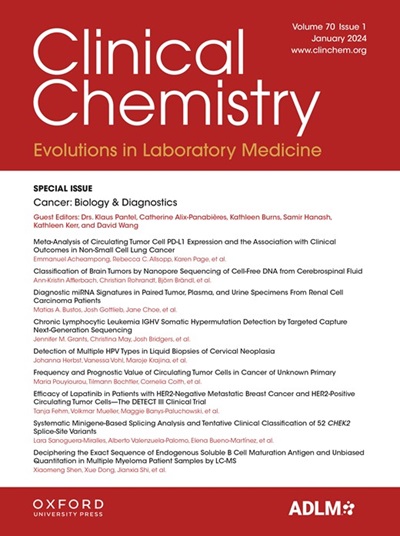B-179 Comparative Evaluation of Cisplatin Release from Alginate Hydrogels with Embedded Silver Nanoparticles: An HPLC and Colorimetric Spectrophotometry Study
IF 7.1
2区 医学
Q1 MEDICAL LABORATORY TECHNOLOGY
引用次数: 0
Abstract
Background Cisplatin [cis-dichlorodiamine platinum (II)], is a well-recognized chemotherapeutical drug. Cisplatin has been employed in treating a wide range of human cancers, such as those of the breast, bladder, lung, ovarian, and testicular cancers. Its therapeutic action is attributed to its capacity to form crosslinks with the DNA's purine bases, disrupting DNA repair processes, causing DNA damage, and ultimately leading to apoptosis in cancerous cells. Nonetheless, the application of cisplatin is constrained by the development of multidrug resistance and the occurrence of severe adverse effects, including nephrotoxicity, bone marrow suppression, hearing loss, allergic responses, nerve damage, and low magnesium levels in the blood. Numerous strategies have been explored to enhance the anticancer effectiveness of cisplatin while minimizing its associated toxicities. These strategies include combination therapies that incorporate nanoparticles, liposomes, and polymer micelles. In this project, cisplatin was embedded into alginate hydrogels loaded with silver nanoparticles and in vitro cisplatin release study using HPLC and UV-Vis spectrophotometry were studied. Methods We developed a novel nanocomplex by integrating silver nanoparticles (AgNPs) with alginate hydrogel coating to create a versatile platform for drug delivery. To incorporate the chemotherapeutic agent, cisplatin (150 ppm) was introduced into the AgNPs-alginate mixture utilizing rapid stirring to ensure uniform distribution and encapsulation of cisplatin within the nanocomplex. A range of analytical methods, such as UV-Vis, FTIR, SEM/EDX, and Zeta potential analysis, were employed to characterize the nanocomplex. To evaluate cisplatin release kinetics from the nanocomplex, we employed an in vitro dialysis method for monitoring its sustained release. High-performance liquid chromatography (HPLC) was used for precise cisplatin release quantification, then validated by colorimetric spectrophotometry. This dual-method approach ensured accurate insights into the nanocomplex’s release dynamics, substantiating its potential in enhancing targeted cancer therapy through advanced drug delivery systems. Results The analysis through UV-Vis revealed an absorption spectrum around 410 nm, indicative of the characteristic plasmon resonance associated with silver nanoparticles. TEM provided high-resolution imagery, revealing that the size of the silver nanoparticles varied between 4 and 30 nm, averaging at 13 nm with a standard deviation of 5 nm specifically for the alginate-coated AgNPs. SEM images confirmed the anticipated spherical distribution of silver nanoparticles within the alginate hydrogel framework. EDX spectroscopy analysis further verified the incorporation of silver nanoparticles and platinum within the complex. The cisplatin release studies from this newly developed nanocomplex illustrated a prolonged, slow, and consistent release pattern, extending over days, in stark contrast to the rapid and complete release of cisplatin from its unbound state, which achieved peak release within an hour. Conclusions In this study, we successfully developed and validated an innovative, multifunctional nanoplatform for drug delivery, comprising alginate hydrogel synergistically co-loaded with silver nanoparticles (AgNPs) and cisplatin. This novel drug carrier system demonstrated a marked enhancement in the controlled delivery of cisplatin, evidenced by the slow and sustained release profile observed over three days. The slow and sustained release of cisplatin from the alginate complex, compared to the free form, highlights the efficacy of the nanoplatform in modulating the drug’s release kinetics.B-179 嵌入银纳米颗粒的藻酸盐水凝胶中顺铂释放的比较评估:高效液相色谱法和比色分光光度法研究
背景 顺铂[顺式二氯二胺铂(II)]是一种公认的化疗药物。顺铂已被用于治疗多种人类癌症,如乳腺癌、膀胱癌、肺癌、卵巢癌和睾丸癌。其治疗作用归因于它能与 DNA 的嘌呤碱基形成交联,破坏 DNA 修复过程,造成 DNA 损伤,最终导致癌细胞凋亡。然而,顺铂的应用受到多药耐药性和严重不良反应的限制,这些不良反应包括肾毒性、骨髓抑制、听力损失、过敏反应、神经损伤和血液中镁含量过低。为了提高顺铂的抗癌效果,同时最大限度地减少其相关毒性,人们探索了许多策略。这些策略包括结合纳米粒子、脂质体和聚合物胶束的组合疗法。在本项目中,我们将顺铂嵌入装有银纳米粒子的藻酸盐水凝胶中,并使用高效液相色谱法和紫外可见分光光度法对顺铂的体外释放进行了研究。方法 我们将银纳米粒子(AgNPs)与海藻酸盐水凝胶涂层相结合,开发出了一种新型纳米复合物,从而创建了一个多功能的给药平台。为了加入化疗药物,我们利用快速搅拌将顺铂(150 ppm)引入 AgNPs-海藻酸盐混合物,以确保顺铂在纳米复合物中的均匀分布和包裹。采用了一系列分析方法,如紫外可见光、傅立叶变换红外光谱、扫描电镜/电子显微镜和 Zeta 电位分析,对纳米复合物进行了表征。为了评估顺铂从纳米复合物中的释放动力学,我们采用了体外透析法来监测其持续释放。采用高效液相色谱法(HPLC)对顺铂释放进行精确定量,然后用比色分光光度法进行验证。这种双重方法确保了对纳米复合物释放动态的准确了解,证实了其通过先进的给药系统加强癌症靶向治疗的潜力。结果 紫外可见光谱分析显示了 410 纳米附近的吸收光谱,表明了与银纳米粒子相关的等离子共振特征。TEM 提供了高分辨率图像,显示银纳米粒子的大小在 4 纳米到 30 纳米之间,平均为 13 纳米,标准偏差为 5 纳米,特别是藻酸盐包裹的 AgNPs。SEM 图像证实了银纳米粒子在海藻酸盐水凝胶框架内的预期球形分布。EDX 光谱分析进一步证实了银纳米粒子和铂在复合物中的结合。对这种新开发的纳米复合物进行的顺铂释放研究表明,其释放模式持久、缓慢且稳定,可持续数天,这与顺铂在未结合状态下的快速完全释放形成了鲜明对比,后者在一小时内就达到了释放峰值。结论 在本研究中,我们成功开发并验证了一种创新的多功能纳米给药平台,该平台由协同共载银纳米粒子(AgNPs)和顺铂的藻酸盐水凝胶组成。这种新型药物载体系统明显增强了顺铂的控制给药能力,三天内缓慢而持续的释放曲线就是证明。与游离态相比,海藻酸盐复合物能缓慢而持续地释放顺铂,这凸显了纳米平台在调节药物释放动力学方面的功效。
本文章由计算机程序翻译,如有差异,请以英文原文为准。
求助全文
约1分钟内获得全文
求助全文
来源期刊

Clinical chemistry
医学-医学实验技术
CiteScore
11.30
自引率
4.30%
发文量
212
审稿时长
1.7 months
期刊介绍:
Clinical Chemistry is a peer-reviewed scientific journal that is the premier publication for the science and practice of clinical laboratory medicine. It was established in 1955 and is associated with the Association for Diagnostics & Laboratory Medicine (ADLM).
The journal focuses on laboratory diagnosis and management of patients, and has expanded to include other clinical laboratory disciplines such as genomics, hematology, microbiology, and toxicology. It also publishes articles relevant to clinical specialties including cardiology, endocrinology, gastroenterology, genetics, immunology, infectious diseases, maternal-fetal medicine, neurology, nutrition, oncology, and pediatrics.
In addition to original research, editorials, and reviews, Clinical Chemistry features recurring sections such as clinical case studies, perspectives, podcasts, and Q&A articles. It has the highest impact factor among journals of clinical chemistry, laboratory medicine, pathology, analytical chemistry, transfusion medicine, and clinical microbiology.
The journal is indexed in databases such as MEDLINE and Web of Science.
 求助内容:
求助内容: 应助结果提醒方式:
应助结果提醒方式:


